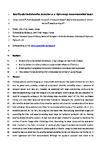Satellite-derived shoreline detection at a high-energy meso-macrotidal beach
| dc.contributor.author | Castelle, B | |
| dc.contributor.author | Masselink, Gerd | |
| dc.contributor.author | Scott, Tim | |
| dc.contributor.author | Stokes, C | |
| dc.contributor.author | Konstantinou, A | |
| dc.contributor.author | Marieu, V | |
| dc.contributor.author | Bujan, S | |
| dc.date.accessioned | 2021-05-06T20:07:14Z | |
| dc.date.available | 2021-05-06T20:07:14Z | |
| dc.date.issued | 2021-06-15 | |
| dc.identifier.issn | 0169-555X | |
| dc.identifier.issn | 1872-695X | |
| dc.identifier.other | 107707 | |
| dc.identifier.uri | http://hdl.handle.net/10026.1/17093 | |
| dc.description.abstract |
Publicly available satellite imagery can now provide multi-decadal time series of shoreline data from local to global scale, enabling analysis of sandy beach shoreline variability across a spectrum of temporal scales. Such data can, however, be associated with large uncertainties, particularly for beaches experiencing a large tidal range (>2 m) and energetic incident waves. We use a decade of bi-monthly topographic surveys at the high-energy meso-macrotidal beach of Truc Vert, southwest France, and concurrent wave and water-level hindcast to investigate the uncertainties associated with satellite-derived time series of the shoreline position. We show that consideration of the water level and wave runup elevation is critical for accurately estimating waterline position and, in turn, shoreline position. At Truc Vert, including non-tidal water level residuals (e.g. wind-driven surge) and accounting for time- and elevation-varying beach slope for horizontal correction did not improve satellite-derived shoreline position. A new total water level threshold is proposed to maximize the number of usable images while minimizing errors. Accounting for wave runup and the new water level threshold at Truc Vert, the number of usable satellite images is doubled and shoreline position errors are at least halved compared to previous work at this site. Using the 1984–2019 reconstructed shoreline, we also show that the satellite-derived shoreline trends and interannual variability are in better agreement with field measurements. Although the approach proposed here needs to be tested on other sites in different tidal/wave forcing environments with different morphological and sediment characteristics, we anticipate that it will improve the temporal and spatial description of shoreline change on most surf tidal beaches where accurate continuous water level and wave hindcasts and/or observations are available. | |
| dc.format.extent | 107707-107707 | |
| dc.language | en | |
| dc.language.iso | en | |
| dc.publisher | Elsevier BV | |
| dc.rights | Attribution-NonCommercial 4.0 International | |
| dc.rights | Attribution-NonCommercial 4.0 International | |
| dc.rights | Attribution-NonCommercial 4.0 International | |
| dc.rights | Attribution-NonCommercial 4.0 International | |
| dc.rights | Attribution-NonCommercial 4.0 International | |
| dc.rights | Attribution-NonCommercial 4.0 International | |
| dc.rights.uri | http://creativecommons.org/licenses/by-nc/4.0/ | |
| dc.rights.uri | http://creativecommons.org/licenses/by-nc/4.0/ | |
| dc.rights.uri | http://creativecommons.org/licenses/by-nc/4.0/ | |
| dc.rights.uri | http://creativecommons.org/licenses/by-nc/4.0/ | |
| dc.rights.uri | http://creativecommons.org/licenses/by-nc/4.0/ | |
| dc.rights.uri | http://creativecommons.org/licenses/by-nc/4.0/ | |
| dc.subject | Shoreline change | |
| dc.subject | Long-term trend | |
| dc.subject | Satellite | |
| dc.subject | Wave runup | |
| dc.title | Satellite-derived shoreline detection at a high-energy meso-macrotidal beach | |
| dc.type | journal-article | |
| dc.type | Journal Article | |
| plymouth.author-url | https://www.webofscience.com/api/gateway?GWVersion=2&SrcApp=PARTNER_APP&SrcAuth=LinksAMR&KeyUT=WOS:000640909500002&DestLinkType=FullRecord&DestApp=ALL_WOS&UsrCustomerID=11bb513d99f797142bcfeffcc58ea008 | |
| plymouth.volume | 383 | |
| plymouth.publication-status | Published | |
| plymouth.journal | Geomorphology | |
| dc.identifier.doi | 10.1016/j.geomorph.2021.107707 | |
| plymouth.organisational-group | /Plymouth | |
| plymouth.organisational-group | /Plymouth/Faculty of Science and Engineering | |
| plymouth.organisational-group | /Plymouth/Faculty of Science and Engineering/School of Biological and Marine Sciences | |
| plymouth.organisational-group | /Plymouth/REF 2021 Researchers by UoA | |
| plymouth.organisational-group | /Plymouth/REF 2021 Researchers by UoA/UoA07 Earth Systems and Environmental Sciences | |
| plymouth.organisational-group | /Plymouth/Research Groups | |
| plymouth.organisational-group | /Plymouth/Research Groups/Marine Institute | |
| plymouth.organisational-group | /Plymouth/Users by role | |
| plymouth.organisational-group | /Plymouth/Users by role/Academics | |
| plymouth.organisational-group | /Plymouth/Users by role/Researchers in ResearchFish submission | |
| dcterms.dateAccepted | 2021-03-16 | |
| dc.rights.embargodate | 2022-3-20 | |
| dc.identifier.eissn | 1872-695X | |
| dc.rights.embargoperiod | Not known | |
| rioxxterms.versionofrecord | 10.1016/j.geomorph.2021.107707 | |
| rioxxterms.licenseref.uri | http://creativecommons.org/licenses/by-nc/4.0/ | |
| rioxxterms.licenseref.startdate | 2021-06-15 | |
| rioxxterms.type | Journal Article/Review | |
| plymouth.funder | Physical and biological dynamic coastal processes and their role in coastal recovery (BLUE-coast)::NERC | |
| plymouth.funder | Physical and biological dynamic coastal processes and their role in coastal recovery (BLUE-coast)::NERC |



